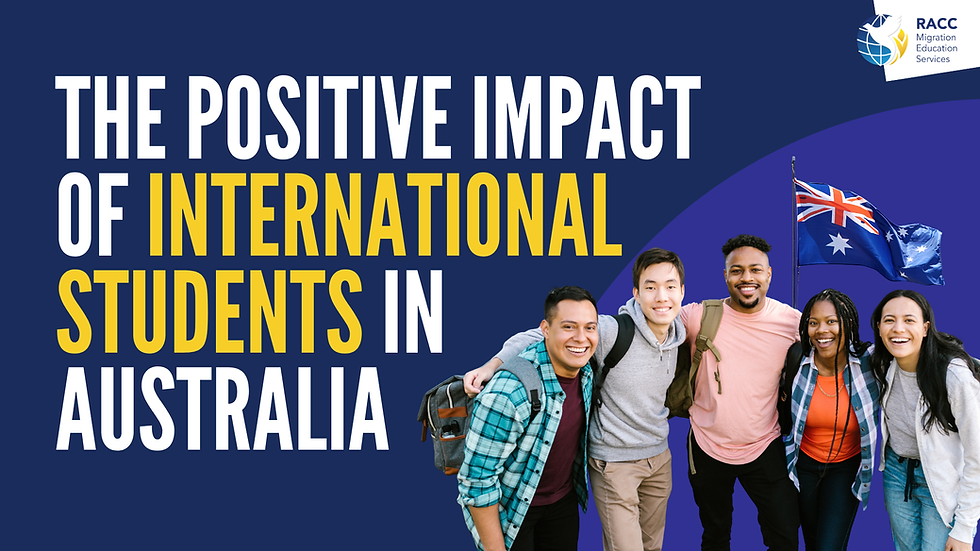The Positive Impact of International Students in Australia
- RACC Australia - Education and Migration Services
- Jul 31
- 3 min read

Education exports are now Australia’s fourth largest export category, valued at around $50 billion in the 2023/24 financial year. In addition to boosting demand, international students also enhance the economy’s supply capacity by working while studying. International students are the second largest group of temporary visa holders with work rights in Australia, following New Zealand citizens, making them an important potential source of labour for the Australian economy.
Recent Trends in International Student Numbers
After COVID-19, Australia’s borders reopened in late 2021, the number of international students onshore rose rapidly—from under 300,000 in 2022 to 560,000 by the end of 2023. This sharp increase made international students an important driver of net overseas migration, accounting for around half of Australia’s total net migration during this period. Their spending played a key role in boosting consumer demand and supporting the country’s economic recovery following the pandemic.
In addition, as student numbers recovered, a larger share pursued higher education courses, further strengthening the education sector. Despite recent policy changes and slower growth in new visa grants, the number of international students onshore remains near record highs, continuing to bring significant economic and cultural benefits to Australia.
Contributions from International Students in Australia
The average weekly expenditure of international students as per BOP data suggests they spend twice as much as residents. The reason is mainly because tuition fees alone make up roughly 40 per cent of their total spending. Fees paid by international students have significant spillover benefits for university research, employment and capital expenditure.
Industries such as accommodation and food, transport, and housing receive a slightly larger share of this spending, while areas like business services and retail see a smaller share. All spending by international students in Australia on tuition fees and all other goods and services is recorded as an education export in Australia’s Balance of Payments (ABS 2024)
Role of International Students in the Labour Market
International students also contribute to the economy’s supply potential because many will work while they are in Australia. If an international student is employed in Australia while studying, payments from their employer are recorded in the primary income account as Compensation of Employees (COE) to non-residents
A greater share of international students work in accommodation and food, as well as retail, compared with the share of the total labour force. Further, an increasing share of students are now working in health care, consistent with strong labour demand in this sector. This contribution was important in helping businesses in these sectors facing labour shortages in the tight labour market that emerged post-pandemic
Over time, many international students transition to temporary graduate visas or permanent residency. About 30 per cent of international students went on to apply for temporary graduate visas in the five years to 2022, with this share having risen over time, and international students making up around one-third of Australia’s permanent resident intake (Department of Education 2022)
The Housing Market Impact of International Students
International students are more likely to rent than Australian residents. About 50 per cent of over 70,000 international students surveyed in the 2023 Student Experience Survey reported that they rent in the private rental market (either in a private rented house, flat or room). Housing demand from international students also tends to be geographically concentrated around areas where educational institutions are based. With 50% of international students renting privately, their housing demand is concentrated near educational institutions, often in inner-city areas. An increase of 100,000 students can raise rental demand by 50,000, potentially increasing rents by around 0.5% in the short term.
While this demand can pressure the rental market, especially in high-density areas, purpose-built student accommodation is expanding to address this. However, broader housing investment may remain limited due to planning and supply constraints.
How to Study in Australia as an International Student: Book A Consultation
Studying in Australia offers more than just a quality education—it’s a pathway to new opportunities, work experience, and future migration options. With strong demand for international students across universities and industries, now is a great time to begin your journey.
Book a free consultation with RACC Australia. We’ll help you choose the right course, prepare your student visa application, and provide ongoing support throughout your studies.







Comments